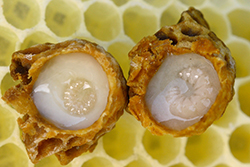您的購物籃內沒有商品!
Its use by Bees
Royal Jelly is a substance produced by young worker bees (bees between five and fourteen days old). Usually called "bee milk" in the beekeeping industry, royal jelly is required for the development of larvae which are all fed the same way until the third day.
Only the larvae selected to become queens will be fed royal jelly after the third day. This pearl of the Beehive becomes the Queen's only food and helps her live for five years, on average.
As for the larvae, their initial weight increases 1800 times in just a few days. That shows how nourishing Royal Jelly is for bees!
The pale yellow, strong-smelling substance contains:

Bees produce just enough Royal Jelly to raise their broods. Contrary to Honey and Pollen, it isn't stored, making it a truly rare beehive product and explaining its often prohibitive price.
Royal jelly is required for the daily life of a normal hive and can't be harvested from hives used for honey or pollen. Beekeepers must specialize some of their bees for this purpose by "forcing" colonies to produce excess royal jelly. Beekeepers create orphan hives by removing the queen. They then harvest every three days, carefully vacuuming up the royal jelly from the brood cells.
The difficulty of harvesting royal jelly and its rarity lead many people to call it the "caviare of the Beehive". It is often eaten pure. It has a very special taste which is both acidic and sweet at the same time.
Propolia® uses it in its food supplement tonics like Energie vitale®, and for its antioxidant properties in its cosmetics products.